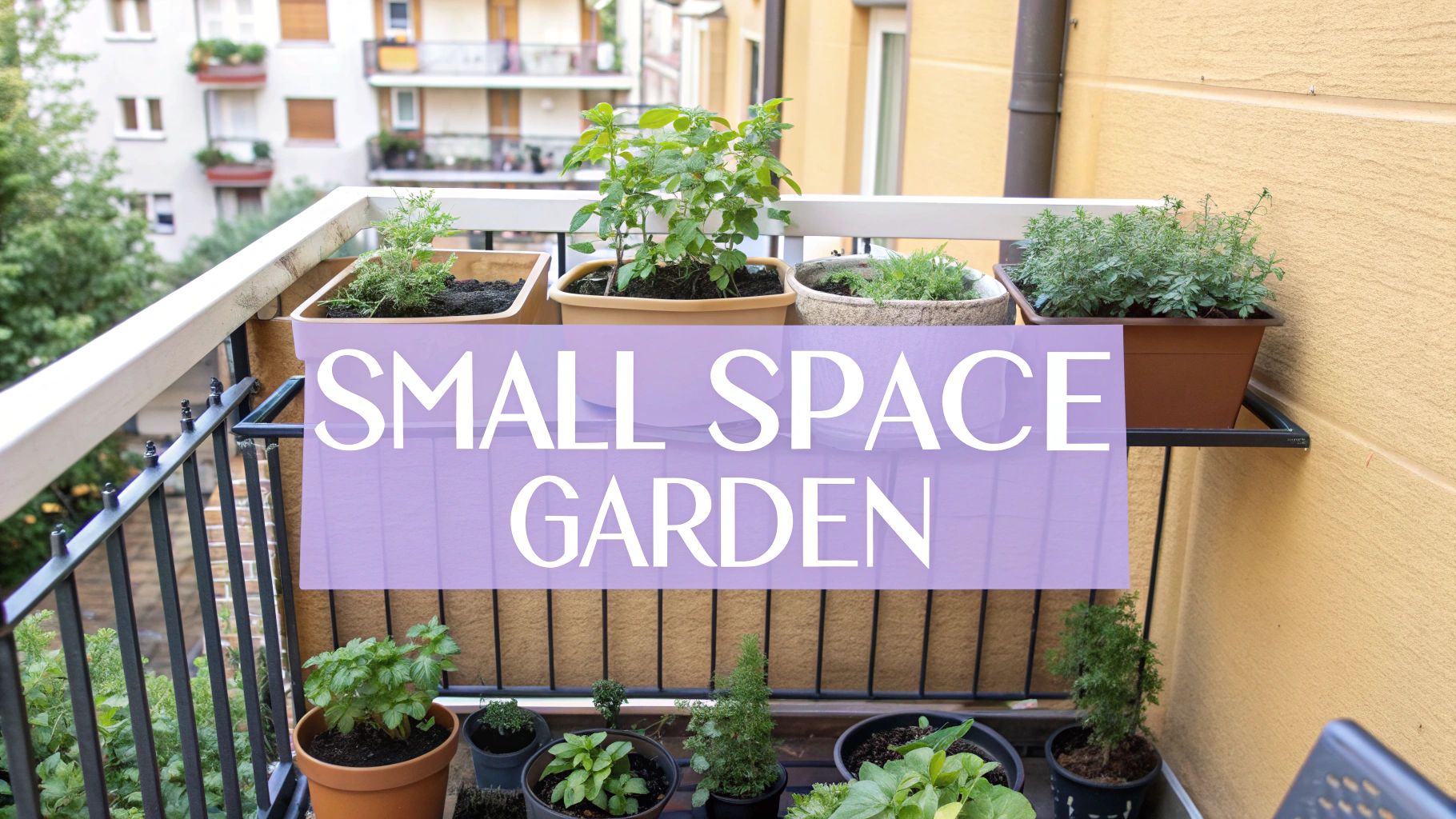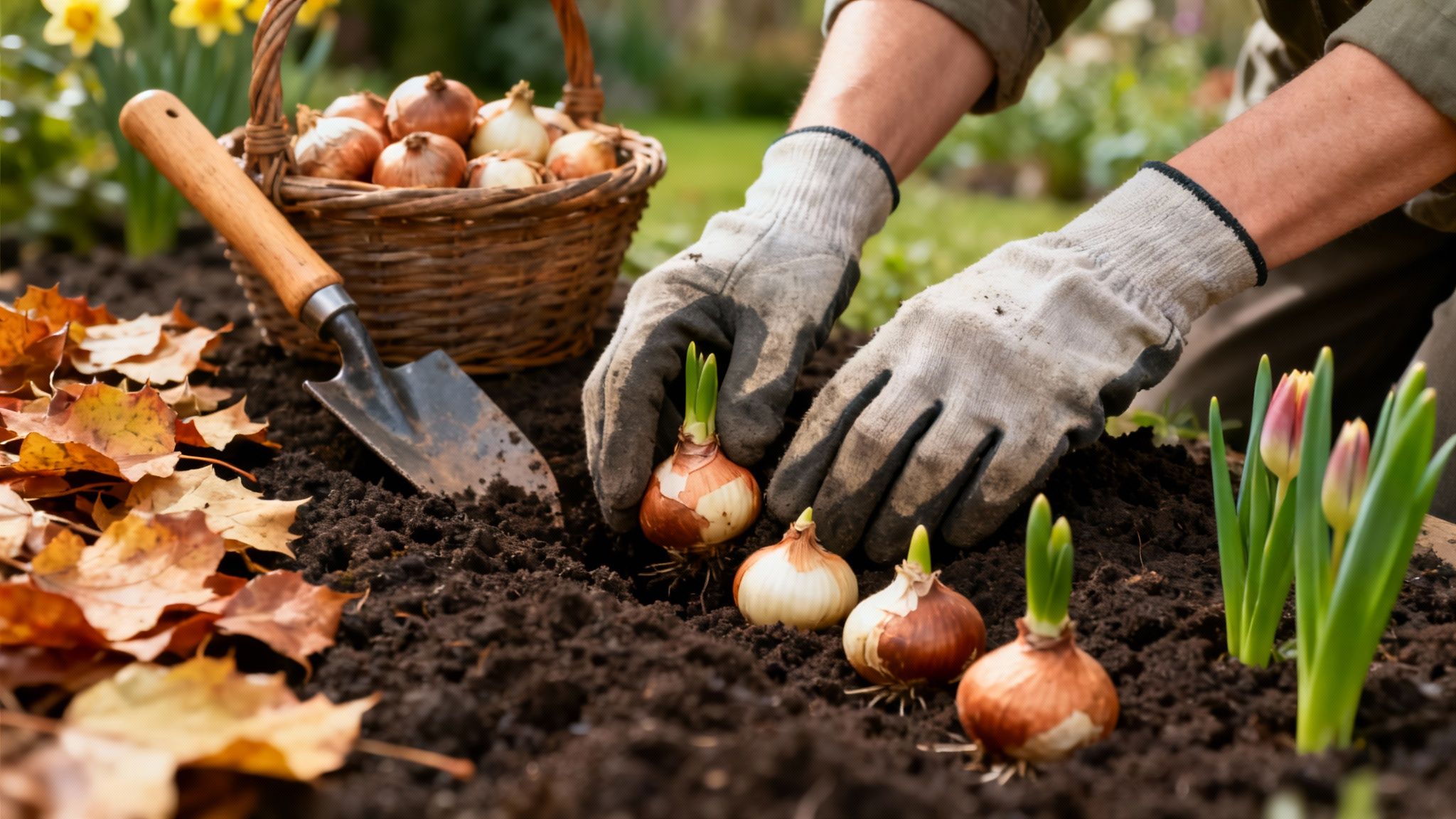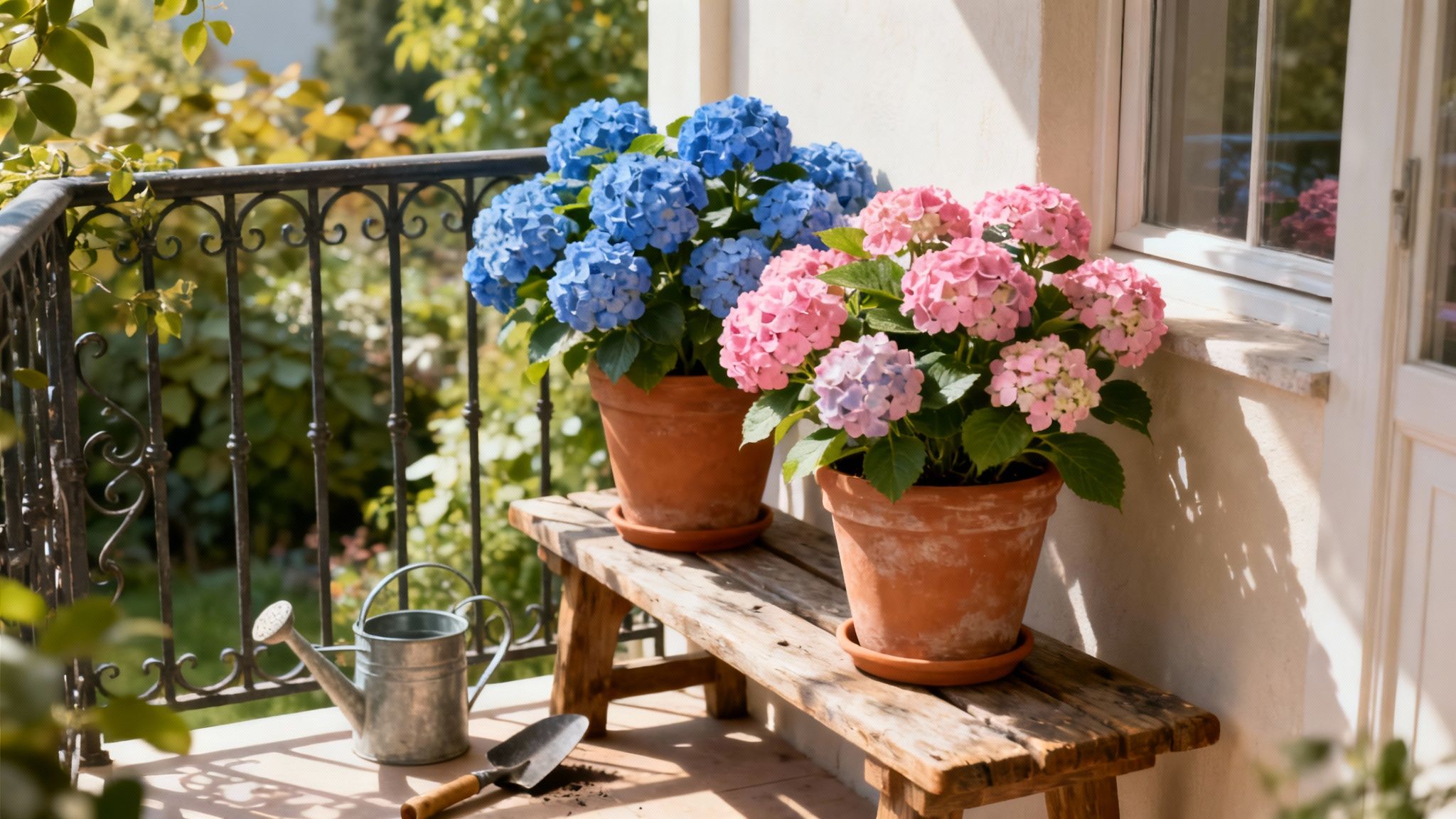Imagine stepping onto your balcony to be greeted by a cascade of fresh strawberries, or snipping culinary herbs right from your kitchen windowsill. A lack of a sprawling lawn is no longer a barrier to a flourishing garden. With a dash of creativity and the right techniques, even the most compact urban dwelling can transform into a verdant, productive oasis. This guide is dedicated to unlocking your home's green potential, no matter its size, by exploring a curated collection of practical small space gardening ideas.
We will delve into nine distinct and stylish solutions, from sophisticated vertical gardens and hydroponic systems to clever uses for hanging baskets and windowsills. Each idea is designed to be actionable, helping you maximise every square centimetre of your available space, whether that's a tiny patio, a narrow balcony, or a sun-drenched kitchen counter. Forget the notion that gardening requires a large plot of land. These methods prove that anyone can cultivate their own food, flowers, and foliage. Whether you are a seasoned gardener adapting to a smaller footprint or a complete novice eager to begin, these concepts will provide the inspiration and practical steps to grow a beautiful and rewarding garden right where you live.
1. Vertical Garden Towers: Reaching for the Sky
When ground space is a luxury you simply don't have, the most logical solution is to grow upwards. Vertical garden towers are one of the most effective small space gardening ideas, transforming a single square foot of a patio, balcony, or even a bright indoor corner into a highly productive green column. These systems consist of multi-tiered, stackable planters that create numerous pockets for growing a variety of plants in a minimal footprint.
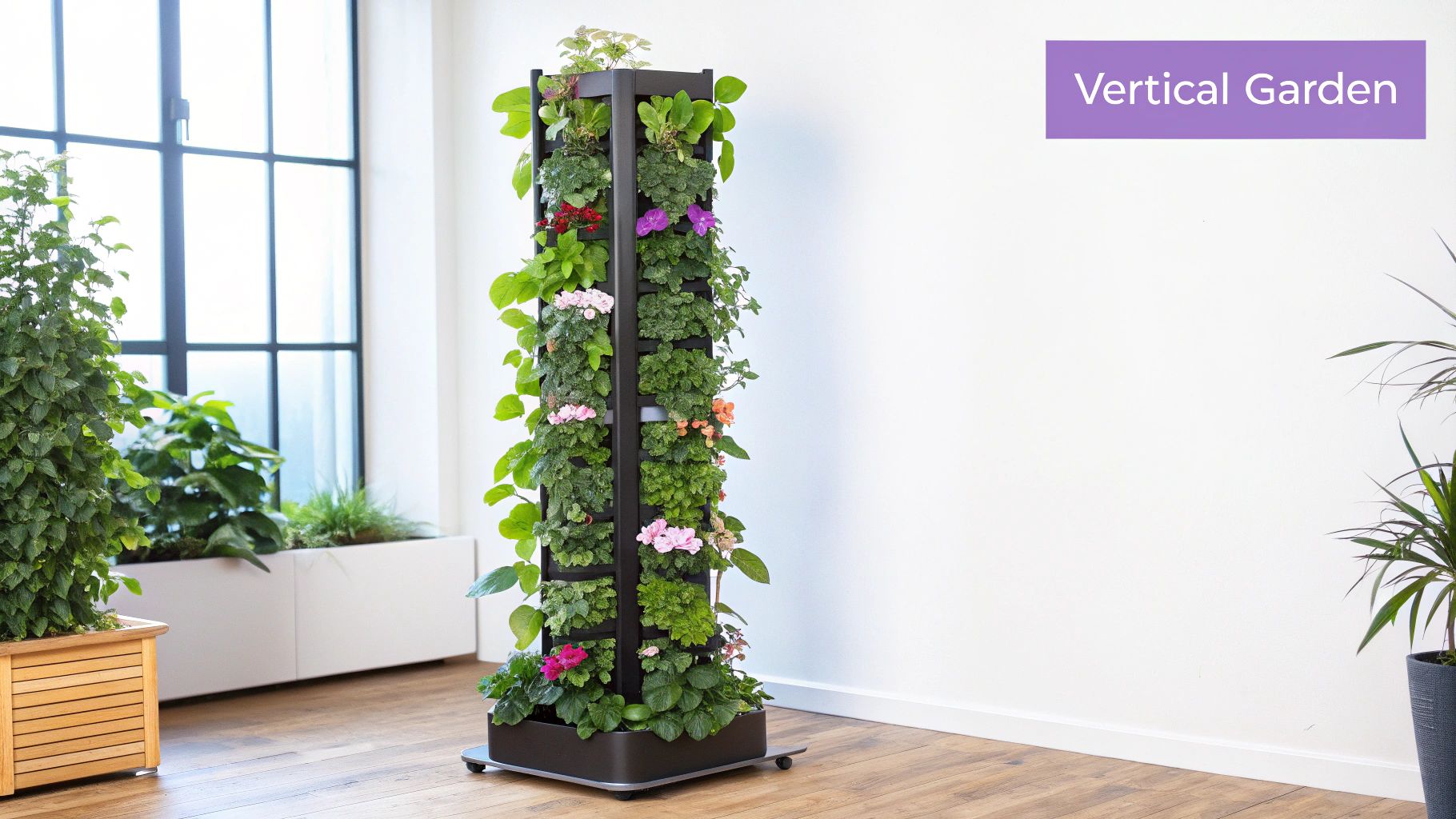
This method is ideal for anyone looking to maximise their harvest of herbs, leafy greens, strawberries, or compact flowers. Brands like GreenStalk and Mr. Stacky have popularised sturdy, soil-based towers, while high-tech options like the Tower Garden use an aeroponic system, misting the plant roots with a nutrient solution and requiring no soil at all. The self-contained design makes them remarkably tidy and efficient.
Pro Tip: Utilise a lightweight, high-quality potting mix specifically formulated for containers. This reduces the overall weight of the tower, making it easier to move, and ensures excellent aeration and drainage for healthy root development.
Maximising Your Tower's Potential
To get the most from your vertical garden, a little strategic planning goes a long way.
- Sunlight Strategy: Place sun-loving plants like tomatoes or peppers in the top tiers where they receive the most light. More shade-tolerant species, such as lettuce or spinach, will thrive in the lower pockets, which are often partially shaded by the tiers above.
- Even Exposure: To ensure all plants receive adequate sunlight, rotate the entire tower a quarter-turn every few days. This simple action prevents one side from flourishing while the other struggles.
- Watering Wisely: Good drainage is crucial. Ensure the base allows excess water to escape to prevent the bottom tiers from becoming waterlogged, which can lead to root rot. Many modern systems feature clever internal irrigation that waters each tier evenly from top to bottom.
2. Hydroponic Window Gardens: The Future of Indoor Cultivation
Imagine harvesting fresh basil or crisp lettuce directly from your windowsill, regardless of the season. Hydroponic window gardens make this a reality by eliminating soil altogether. These are some of the most innovative small space gardening ideas, using a nutrient-rich water solution to deliver everything plants need directly to their roots. These compact, often automated systems fit perfectly in bright spots indoors, offering a high-tech, low-mess way to grow year-round.
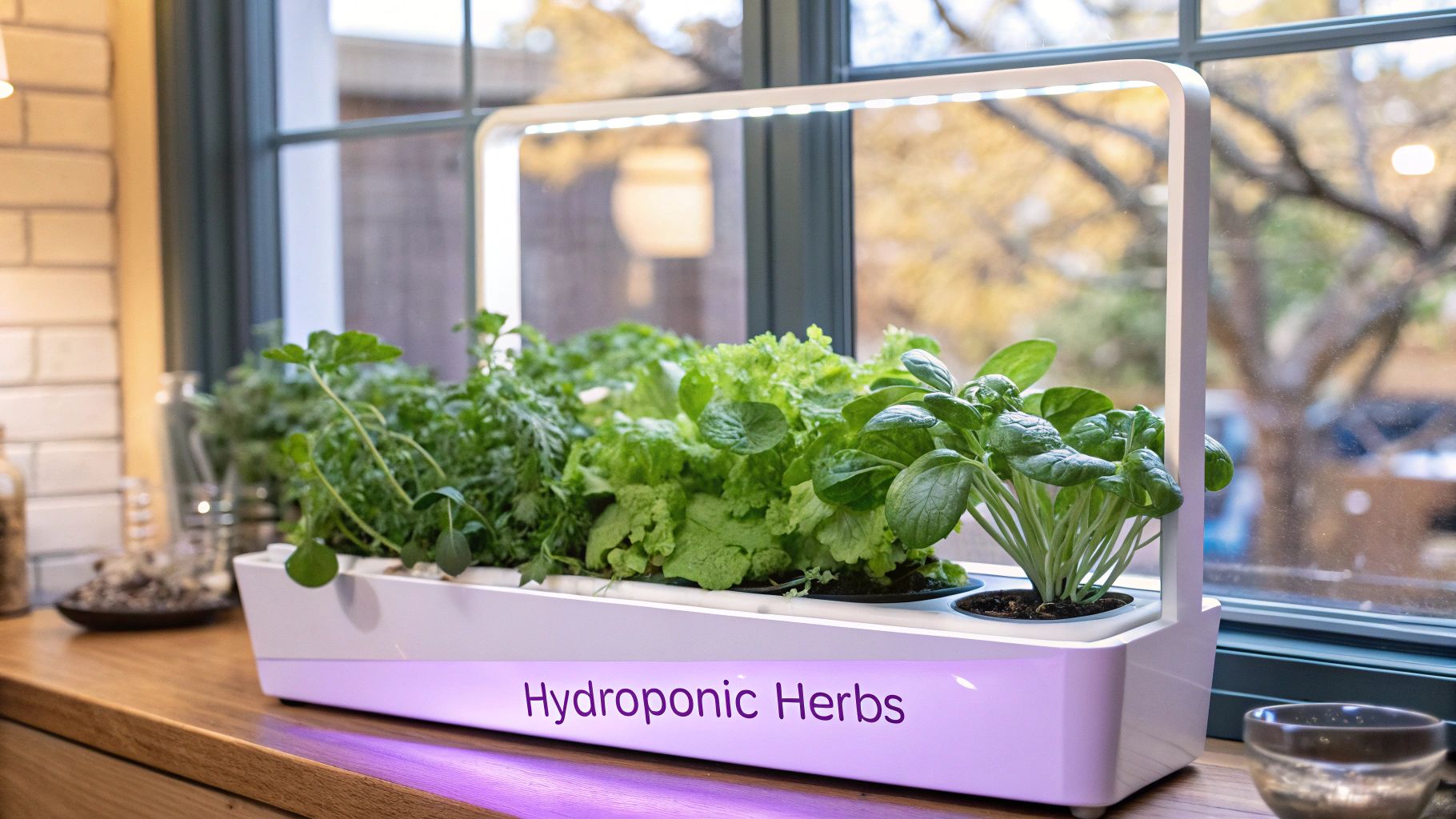
This soilless method is ideal for growing herbs, leafy greens, and even small fruiting plants like cherry tomatoes or chillies with minimal effort. Brands such as AeroGarden and Click & Grow have perfected countertop models that often include built-in LED grow lights, making them independent of natural sunlight. This means even a dark kitchen corner can become a productive miniature farm, bringing fresh flavours right to your fingertips.
Pro Tip: Always use distilled or filtered water for your hydroponic system. Tap water can contain minerals and chlorine that may build up over time and affect the nutrient balance, potentially harming your plants.
Maximising Your Hydroponic Harvest
A little routine maintenance will ensure your indoor garden thrives and produces consistently.
- Nutrient Management: Hydroponic success hinges on the correct nutrient solution. Follow the manufacturer's instructions for mixing and change the water and nutrient solution completely every two to three weeks to prevent nutrient imbalances and keep the water fresh.
- Encourage Bushy Growth: Regularly prune herbs like basil and mint to prevent them from becoming "leggy" or flowering too early. This encourages the plant to grow bushier, giving you a more generous and continuous harvest from a single plant.
- System Hygiene: Clean the entire system thoroughly between plantings. Disassemble the unit and wash all components with a mild soap or a diluted vinegar solution to remove any algae or mineral deposits, ensuring a healthy start for your next crop.
3. Living Walls and Green Walls: A Tapestry of Greenery
For a truly dramatic and space-saving statement, a living wall transforms an entire vertical surface into a lush, growing tapestry. Unlike stacked planters, these green walls involve plants growing directly on a wall using specialised systems like felt pockets, modular panels, or frame-mounted hydroponics. This is one of the most visually stunning small space gardening ideas, turning a blank exterior wall or an indoor feature wall into a vibrant work of art.
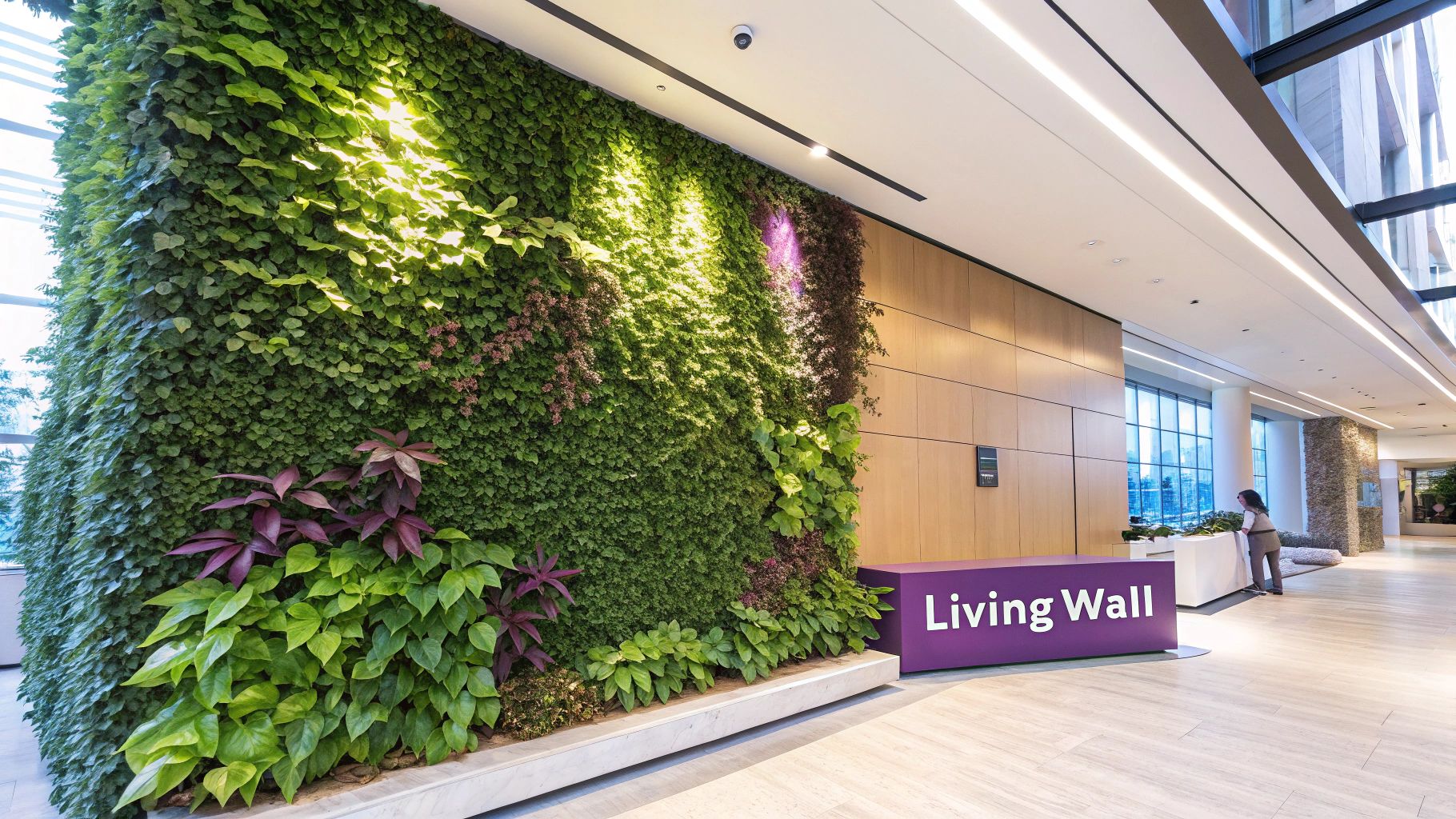
This method was popularised by botanist Patrick Blanc and made accessible by brands like Florafelt and Woolly Pocket. It’s perfect for growing a dense arrangement of ferns, succulents, herbs, or ornamental grasses. The effect is immersive, improving air quality and providing excellent insulation. While ambitious, the payoff is a breathtaking green feature that occupies zero floor space, making it ideal for narrow balconies, courtyards, or even living rooms.
Pro Tip: Ensure a professional waterproof membrane is installed behind the system to protect the wall structure from moisture damage. This is a non-negotiable step for long-term success and structural integrity.
Engineering Your Living Wall
A successful green wall requires careful planning, from installation to plant selection.
- Plant Grouping: Select plants with similar light, water, and nutrient requirements. Grouping species like drought-tolerant succulents together or moisture-loving ferns in another section simplifies maintenance and ensures all plants thrive.
- Irrigation is Key: Most living wall systems incorporate a built-in irrigation system, often a drip line that runs across the top. Ensure it's functioning correctly and provides even coverage to prevent dry patches from developing.
- Start with Hardy Plants: If you are new to living walls, begin with resilient, low-maintenance plants like spider plants, pothos, or sedums. These are more forgiving of initial mistakes as you learn the specific maintenance needs of your wall.
4. Hanging Basket Gardens: Cascading Colour from Above
Hanging baskets are a timeless and elegant solution for adding greenery without consuming any floor or surface space. By utilising overhead areas on balconies, porches, or from ceiling hooks indoors, they create vibrant, suspended displays. This is one of the classic small space gardening ideas, perfect for bringing eye-level interest and cascading colour to otherwise unused vertical planes. They draw the eye upwards, making a small area feel larger and more immersive.

From traditional coconut fibre-lined wire baskets to modern self-watering planters and artisanal macrame hangers, the options are vast. They are exceptionally well-suited for trailing plants like petunias, fuchsias, and ivy, but can also host compact edibles such as cherry tomatoes, strawberries, and various herbs. The key is to transform empty air into a productive and beautiful gardening zone.
Pro Tip: Before planting, line your basket with a layer of plastic from an old compost bag, piercing a few drainage holes in it. This will significantly reduce water loss through evaporation and runoff, keeping your plants hydrated for longer.
Making the Most of Your Hanging Garden
A successful hanging basket is a balance of horticultural science and artful design.
- Weight and Safety: Always use a high-quality, lightweight potting mix to minimise strain on the support structure. Crucially, ensure that any brackets, hooks, or chains are securely installed and rated to hold the full weight of a mature, watered basket.
- Plant Grouping: To simplify care, group plants with similar light and water requirements together in the same basket. A sun-loving, drought-tolerant mix of succulents will have very different needs from a shade-loving, thirsty fern and impatiens combination.
- Consistent Care: Baskets dry out much faster than ground-level containers due to air circulation on all sides. Check the soil moisture daily, especially during warm, windy weather, and be prepared to water frequently. A self-watering planter can be a great help here.
5. Raised Bed Gardening: Defining Your Growing Space
Even in smaller gardens or courtyards, creating a dedicated growing area can dramatically improve your results. Raised bed gardening involves building an above-ground frame that you fill with high-quality soil, offering one of the most customisable small space gardening ideas. These defined beds solve common gardening problems like poor native soil, compaction, and inadequate drainage, giving you complete control over the growing environment.
This method is perfect for patios, small lawns, or any area where in-ground planting isn't feasible. You can find ready-made kits in materials like attractive cedar, modern galvanised steel, or durable composite lumber. Companies such as Vego Garden and Gardener's Supply Company have popularised modular systems that allow you to construct beds in various shapes and sizes to perfectly fit your available space. They are ideal for growing everything from deep-rooted vegetables like carrots and potatoes to a dense patch of cut flowers.
Pro Tip: When filling your raised bed, use a specific soil blend often called a "triple mix" or "garden soil mix," which typically combines topsoil, compost, and an aeration element like perlite. This creates a nutrient-rich, well-draining medium that is far superior to standard garden soil.
Maximising Your Raised Bed's Potential
A well-planned raised bed can be an incredibly productive and low-maintenance garden.
- Smart Sizing: Construct or place your bed so it is no wider than 4 feet (about 1.2 metres). This ensures you can easily reach the centre from either side without stepping on and compacting the soil.
- Enrich the Soil: Raised beds are closed systems, so nutrients get used up. Top up your bed with a fresh layer of high-quality compost at the beginning of each growing season to replenish nutrients and improve soil structure.
- Efficient Watering: The excellent drainage of raised beds means they can dry out faster than in-ground gardens. Consider installing a simple drip irrigation or soaker hose system on a timer to deliver consistent moisture directly to the plant roots, saving water and time.
6. Container Gardening: The Ultimate in Flexibility
Container gardening is perhaps the most classic and adaptable of all small space gardening ideas, allowing you to grow almost anything, anywhere. This method involves planting in portable containers-from decorative pots to practical grow bags-giving you complete control over soil, water, and placement. It’s the perfect solution for renters, balcony gardeners, or anyone who wants the freedom to rearrange their green space on a whim.
This approach embraces everything from stylish ceramic pots that complement your patio furniture to highly efficient fabric containers like Smart Pots, which promote healthier root systems. For busy individuals, self-watering systems from brands like Lechuza are a game-changer, reducing the frequency of watering. Even repurposed items like old buckets or wooden crates can be transformed into charming, functional planters, adding a touch of personal flair to your garden.
Pro Tip: When choosing a container, always think one size bigger than you believe the plant needs. This provides ample room for root growth, holds more moisture to protect against drying out, and ensures your plant won't become root-bound too quickly.
Maximising Your Container's Potential
A successful container garden relies on a few key principles for thriving, vibrant plants.
- Drainage is Non-Negotiable: Ensure every container has adequate drainage holes at the bottom. Without them, water will pool, starving roots of oxygen and inevitably causing root rot. If a decorative pot lacks holes, you can drill them yourself or use it as a cachepot, placing a smaller nursery pot inside.
- Strategic Grouping: Arrange containers in clusters. This not only creates a lush, visually appealing display but also establishes a humid microclimate around the plants, reducing water loss and stress, especially on hot, windy days.
- Mobility is Your Advantage: Place heavier pots on wheeled plant caddies before you fill them. This makes it effortless to move plants around to chase the sun, protect them from harsh weather, or simply change up your outdoor decor.
7. Windowsill Herb Gardens: Culinary Convenience
The windowsill is often overlooked, yet it represents prime real estate for gardening in a compact home. Windowsill herb gardens are one of the most accessible and rewarding small space gardening ideas, transforming a sliver of sunlit space into a fragrant, edible oasis. These setups place fresh culinary ingredients right where you need them, just an arm's reach from the kitchen.
This idea can be as simple as a few individual terracotta pots or as organised as a custom-built planter box that fits the exact dimensions of your sill. Popular approaches include charming mason jar herb gardens, which add a rustic aesthetic, and even magnetic planters that can affix to metal window frames. The key is utilising the abundant natural light that most windows provide to cultivate a fresh supply of basil, mint, rosemary, or parsley.
Pro Tip: When harvesting herbs like basil or mint, pinch off the top set of leaves just above a leaf node. This encourages the plant to branch out, creating a bushier, more productive plant rather than a single, leggy stem.
Making Your Windowsill Flourish
A successful windowsill garden thrives on attention to detail and understanding your indoor microclimate.
- Light-Matching: Assess your window's orientation. South-facing windows are perfect for sun-loving Mediterranean herbs like rosemary, thyme, and oregano. East or west-facing windows provide moderate light suitable for mint, parsley, and chives.
- Encourage Even Growth: Just like larger plants, windowsill herbs can lean towards the light. Give each pot a quarter-turn every few days to ensure all sides receive sunlight, promoting straight, strong stems and balanced growth.
- Soil and Drainage: Good drainage is non-negotiable. Ensure every pot or planter has drainage holes and use a high-quality, lightweight potting mix. A layer of small pebbles at the bottom of a decorative outer pot can also help keep the roots from sitting in water.
8. Pocket Gardens and Shoe Organisers: The Ultimate Upcycling Hack
Repurposing everyday items is at the heart of creative gardening, and few methods are as clever or budget-friendly as using pocket organisers. This ingenious approach involves transforming fabric shoe organisers or purpose-made felt pocket planters into a vertical wall of green. This is one of the most accessible small space gardening ideas, perfect for covering a bare wall on a balcony, a fence, or even the back of a door.
This method provides dozens of individual growing pouches in a minimal amount of space. It’s an ideal solution for creating a living wall of herbs like mint, thyme, and oregano, or for growing annual flowers and trailing plants like lobelia or petunias. The DIY community on platforms like Pinterest has championed this technique, demonstrating its versatility and affordability for gardeners on any budget.
Pro Tip: If you're using a standard shoe organiser, ensure it's made from a breathable fabric like canvas. You will need to carefully pierce a few small drainage holes in the bottom of each pocket to prevent waterlogging and protect plant roots.
Maximising Your Pocket Garden's Potential
A successful pocket garden relies on a few key considerations to keep it thriving.
- Lightweight Foundation: The single most important factor is the growing medium. Fill each pocket with a lightweight potting mix formulated for containers to avoid putting excessive strain on the organiser and its hanging points.
- Secure Installation: A fully planted and watered organiser can become surprisingly heavy. Ensure you hang it from sturdy, reliable hooks or secure it directly to a wall or fence capable of bearing the weight.
- Planting Strategy: Start with small starter plants or sow seeds directly into the pockets. This gives them time to establish strong root systems within the confined space. Placing thirstier plants in the lower pockets can help them benefit from any moisture that trickles down from above.
9. Balcony and Patio Gardens: Your Outdoor Oasis
A balcony or patio, no matter how small, is a prime piece of real estate for creating a lush, contained garden. These spaces offer the perfect opportunity to combine various small space gardening ideas into a cohesive and productive mini-ecosystem. By leveraging purpose-built planters and clever arrangements, you can transform a bare concrete slab or wooden deck into a vibrant outdoor sanctuary filled with flowers, herbs, and even vegetables.
This approach moves beyond single pots, encouraging a holistic design. Think railing planters from brands like Bloem overflowing with trailing petunias, tiered plant stands creating layers of colour, and compact vegetable troughs for a fresh harvest. The key is to see the space as a whole, utilising floors, walls, and railings to maximise every available inch and create a truly immersive green environment.
Pro Tip: Always check the weight-bearing capacity of your balcony or deck before you start. Use lightweight fibreglass or plastic containers instead of heavy terracotta or concrete, and group heavier pots closer to the building’s structural supports.
Maximising Your Outdoor Space
A successful balcony or patio garden thrives on smart planning and an understanding of its unique microclimate.
- Wind Management: Balconies, especially on higher floors, can be windy. Choose sturdy, low-profile plants like lavender, sedum, or ornamental grasses that can withstand gusts. You can also install discreet bamboo screens or trellises to act as windbreaks, protecting more delicate plants.
- Weather Exposure: Plants on a patio are fully exposed to the elements. Select containers that are frost-proof and UV-resistant to prevent cracking and fading. During intense heatwaves, you may need to provide temporary shade or move pots to a cooler spot.
- Container Grouping: Grouping several pots together not only creates a more impactful visual display but also helps to raise the local humidity, which benefits the plants. This technique also simplifies watering and can provide mutual protection from harsh sun or wind.
9 Small Space Gardening Ideas Comparison
Cultivating Your Green Oasis
As we have journeyed through the myriad of innovative small space gardening ideas, one powerful truth has emerged: a lack of expansive ground is no barrier to a flourishing garden. It is simply an invitation to think differently, to look up, and to cultivate creativity alongside your plants. The limitations of a small flat, a compact patio, or a single sunny window are not dead ends; they are the starting points for some of the most personal and rewarding green spaces imaginable.
We have seen how vertical garden towers can transform a small footprint into a productive column of life, and how hydroponic systems bring futuristic, soil-free cultivation right to your kitchen window. From the artistic statement of a living wall to the simple, cascading beauty of hanging baskets, each solution offers a unique way to integrate nature into your home. The key takeaway is to shift your perspective. Instead of seeing a bare wall, envision a vertical canvas for herbs and flowers. That unused balcony corner? It’s a future home for a multi-tiered container garden bursting with colour and flavour.
Your Next Steps to a Greener Home
Embarking on your gardening journey doesn't require a complete overhaul. The most successful small space gardens begin with a single, manageable step. Consider this your call to action:
- Assess and Select: Review the ideas we’ve explored, from raised beds to windowsill herb gardens. Which one genuinely excites you and fits realistically with your available light, time, and space? Choose one to start with.
- Start Small, Plan Big: Don’t feel pressured to do everything at once. Begin with a single container, a small shoe organiser planter, or a couple of your favourite herbs. Success with one project will build the confidence to expand and layer different techniques.
- Embrace the Process: Gardening is a journey of learning and adaptation. Some plants will thrive, others may not. This is a natural part of the process. Pay attention to what your small space is telling you and enjoy the simple, daily ritual of tending to your plants.
Mastering these concepts is about more than just growing plants. It's about enhancing your living environment, improving your wellbeing, and reconnecting with the natural world in a meaningful, hands-on way. You are not just decorating; you are creating a living, breathing ecosystem that nourishes both body and soul. The satisfaction of snipping fresh herbs for your dinner or watching a flower bloom on your balcony is a profound and accessible joy. Your small space garden is not just a future project; it is a lifestyle waiting to be embraced, one pot, one seed, and one green leaf at a time.

